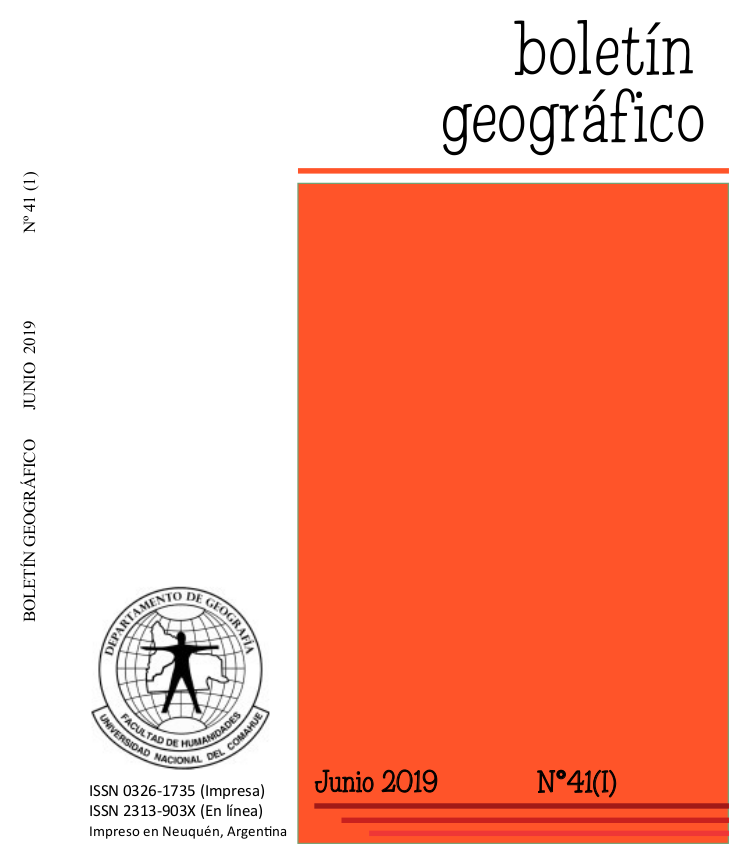“A great place to live”: branding Buenos Aires as an attractive city
Keywords:
Buenos Aires, branding, creative class, global city, urban entrepreneurshipAbstract
The literature on global cities that stands in the tradition of the ‘Globalization and World Cities’ research network neglects the attraction of places for the global knowledge elite and transnational companies. To better understand this phenomenon, the article adopts a ‘place branding’ perspective. Three components of branding global cities are identified: a liveable environment with an inclusive society, events/mega-events, as well as iconic architecture and real-estate projects.Against the backdrop of academic literature, documents published by the city of Buenos Aires and information obtained from the websites of the ministriesof the cityand the organisation InvestBA, the branding strategies of Buenos Aires are analysed. It is shown that Argentina’s capital sees itself as ‘a great place to live’. It presents itself as creative and innovative, as well as equitable and inclusive. Several measures give substance to this image, in particular the rehabilitation of key districts such as Puerto Madero. The extentsof bicycle lanes and the improvement of public transport are other important initiatives. Cultural activities are used by the government of the city as a tool to recover disadvantaged neighbourhoodsand boost the local economy, among other measures through creative poles. The promotion of the attractiveness of Buenos Aires rests on events and mega-events.In the conclusion, pitfalls of branding are addressed, especially the social imbalance that apparently characterises corresponding initiatives in Buenos Aires. Instead of rejecting branding, it is proposed that future academic contributions would be most useful if they told us how to guarantee that branding, in combination with other policies, generates benefits for all citizens, not just for a few who are already privileged.Downloads
References
Anttiroiko, A. V. (2015). City branding as a response to global intercity competition. Growth and Change, 46(2), 233–252.
Anholt, S. (2005). Some important distinctions in place branding. Place Branding, 1(2), 116–121.
Anholt, S. (2007). Competitive identity: the new brand management for nations, cities and regions. Palgrave.
Anholt, S. & Hildreth, J. (2005). Let freedom and cash registers ring: America as a brand. Place Branding and Public Diplomacy, 1(2), 164–172.
Arqueros Mejica, M. S. (2018). Reflexiones en torno a los entramados público-privados: el caso del polo farmacéutico del sur de la ciudad de Buenos Aires. Cuaderno Urbano, 25, 7–29.
Bayardo, R. (2013). Políticas culturales y economía simbólica de las ciudades:“Buenos Aires, en todo estás vos”. Latin American Research Review, 48(edición especial), 100–128.
Boisen, M. (2015). Place branding and non-standard regionalization in Europe. En Zenker, S. & Jacobsen, B. P. (coord.), Inter-regional place branding: best practices, challenges and solutions(pp. 13–23). Springer.
Boisen, M., Terlouw, K., Groote P. & Couwenberg, O. (2018). Reframing place promotion, place marketing, and place branding: moving beyond conceptual confusion. Cities, 80, 4–11.
Braun, E. (2012). Putting city branding into practice. Journal of Brand Management, 19(4), 257–267.
Carman, M. (2006). Las trampas de la cultura: los “intrusos” y los nuevos usos del barrio de Gardel. Buenos Aires: Paidós.
Clark, G., Moonen, T. & Couturier, J. (2015). Globalisation and competition: the new world of cities. Chicago: JLL.
Cronin, A. M. & Hetherington, K. (2008). Consuming the entrepreneurial city: image, memory, spectacle. London: Routledge.
Cuenya, B. & Corral, M. (2011). Empresarialismo, economía del suelo y grandes proyectos urbanos: el modelo de Puerto Madero en Buenos Aires. Eure, 111, 25–45.
Derudder, B. & Taylor, P. J. (2016). Change in the world city network, 2000–2012. Professional Geographer, 68(4), 624–637.
Dupont, V. D. (2011). The dream of Delhi as a global city. International Journal of Urban and Regional Research, 35(3), 533–554.
Etulain, J. C. (2008). ¿Gestión promocional o privatización de la gestión urbanística?: proyecto urbano Puerto Madero, Buenos Aires –Argentina. Bitácora Urbano–Territorial, 12(1), 171–184.
Etulain, J. C. (2009). Gestión urbanística y proyecto urbano: modelos y estrategias de intervención. Buenos Aires: Nobuko.
Florida, R. (2002). The rise of the creative class. New York: Basic Books.
Freire, J. (2005). Geo-branding, are we talking nonsense?: a theoretical reflection on brands applied to places. Place Branding, 1(4), 347–362.
GaWC (2018). The world according to GaWC 2018. Recuperado de https://www.lboro.ac.uk/gawc/world2018t.html
Gibb, M. (2007). Cape Town, a secondary global city in a developing country. Environment and Planning C, 25(4), 537–552.
Girola, M. F., Yacovino, M. P. & Laborde, S. (2011). Recentrando la centralidad: procesos de recualificación urbana y espacio público en la ciudad de Buenos Aires desde una perspectiva etnográfica. Cuaderno Urbano, 10, 25–40.
Gobierno de la Ciudad de Buenos Aires (2007). Plan de marketing turístico de la Ciudad de Buenos Aires. Gobierno de la Ciudad de Buenos Aires.
Gobierno de la Ciudad de Buenos Aires (2017a). Plan Estratégico Participativo Buenos Aires 2035: fase de análisis. Recuperado de https://www.buenosaires.gob.ar/sites/gcaba/files/pepba2035_cuaderno_1_r.pdf
Gobierno de la Ciudad de Buenos Aires (2017b). Plan Estratégico Participativo Buenos Aires 2035: fase propositiva. Recuperado de https://www.buenosaires.gob.ar/sites/gcaba/files/pepba2035_cuaderno_3_r.pdf
Harvey, D. (1989). From managerialism to entrepreneurialism: the transformation in urban governance in late capitalism. Geografiska Annaler B, 71(1), 3–17.
Hiller, H. H. (2000). Mega-events, urban boosterism, and growth strategies: an analysis ofthe objectives and legitimations of the Cape Town 2004 Olympic bid. International Journal of Urban and Regional Research, 24(2), 439–458.
Hospers, G. J. (2007).Pile ‘em high, sell ‘em cheap?Regions, 268, 3.
Hoyler, M., Parnreiter, C. & Watson, A. (coord.) (2018). Global city makers: economic actors and practices in the world city network. Cheltenham: Elgar.
Instituto Nacional de Estadística y Censos (2021). Incidencia de la pobreza y la indigencia en 31 aglomerados urbanos. Recuperado de https://www.indec.gob.ar/uploads/informesdeprensa/eph_pobreza_09_21324DD61468.pdf
Kanai, M. & Ortega Alcázar, I. (2009). The prospects for progressive culture-led urban regeneration in Latin America: cases from Mexico City and Buenos Aires. International Journal of Urban and Regional Research, 33(2), 483–501.
Kavaratzis, M. (2004). From city marketing to city branding: towards a theoretical framework for developing city brands. Journal of Place Branding, 1(1), 58–73.
Kavaratzis, M. & Ashworth, G. J. (2005).City branding: an effective assertion of identity or a transitory marketing trick?. Tijdschrift voor Economische en Sociale Geografie, 96(5), 506–514.
Keeling, D. J. (1996). Buenos Aires: global dreams, local crises. Chichester: Wiley.
Keeling, D. J. (1999). Neoliberal reform and landscape change in Buenos Aires, Argentina. Yearbook of the Conference of Latin Americanist Geographers, 25, 15–32.
Krätke, S. (2014). How manufacturing industries connect cities across the world: extending research on ‘multiple globalizations’. Global Networks, 14(2), 121–147.
Krätke, S. & Taylor, P. J. (2004). A world geography of global media cities. European Planning Studies, 2(4), 459–477.
Lederman, J. (2015). Urban fads and consensual fictions: creative, sustainable, and competitive city policies in Buenos Aires. City & Community, 14(1), 47–67.
Lorentzen, A. (2009). Cities in the experience economy. European Planning Studies, 17(6), 829–845.
Malecki, E. (2004). Jockeying for position: what it means and why it matters to regional development policy when places compete. Regional Studies, 38(9), 1101–1120.
Mans, U. (2013). Revisiting city connectivity. Journal of Economic Geography, 14(1), 155–177.
Musa, G. & Melewar, T. C. (2011). Kuala Lumpur: searching for the right brand. En Dinnie, K. (coord.), City branding: theory and cases(pp. 162–168). London: Palgrave.
Parmenter, G. (2011). The city branding of Sydney. En Dinnie, K. (coord.), City branding: theory and cases (pp. 199–205). London: Palgrave.
Pradilla Cobos, E. (2008). ¿Existen ciudades globalesen América Latina? Ciudades, 77, 2–8.
Robinson, J. (2002). Global and world cities: a view from off the map. International Journal of Urban and Regional Research, 26(3), 531–554.
Rodríguez, A., Moulaert, F. &Swyngedouw, E. (2001). Nuevas políticas urbanas para la revitalización de las ciudades en Europa. Ciudad y Territorio, 129, 409–424.
Rodríguez, M. C. & Di Virgilio, M. M. (2014). Ciudad de Buenos Aires: políticas urbanas neoliberales, transformaciones socio-territoriales y hábitat popular. Revista de Direito da Cidade, 6(2), 323–347.
Scholvin, S. (2021). Ciudades en redes económicas: una comparación de Buenos Aires y Santa Cruz con Singapur, enfocada en el sector de petróleo y gas. Ciudad y Territorio, 210 [artículo por ser publicado].
Sigler, T. J. (2016). After the ‘world city’ has globalised: four agendas towards a more nuanced framework for global urban research. Geography Compass, 10(9), 389–398.
Svampa, M. (2008). Cambio de época: movimientos sociales y poder político. Buenos Aires: Siglo XXI.
Taylor, P. J., Catalano, G. & Walker, D. R. (2002a). Measurement of the world city network. Urban Studies, 39(13), 2367–2376.
Taylor, P. J., Catalano, G. & Walker, D. R. (2002b). Exploratory analysis of the world city network. Urban Studies, 39(13), 2377–2394.
Boletín Geográfico110
Toly, N., Bouteligier, S., Smith, G. & Gibson, B. (2012). New maps, new questions: global cities beyond the advanced producer and financial services sector. Globalizations, 9(2), 289–306.
Turok, I. (2009). The distinctive city: pitfalls in the pursuit of differential advantage. Environment and Planning A, 41(1), 13–30.
Van Meeteren, M., Derudder, B. &Bassens, D. (2016). Can the straw man speak?: an engagement with postcolonial critiques of ‘global cities research’. Dialogues in Human Geography, 6(3), 247–267.
Vanolo, A. (2017). City branding: the ghostly politics of representation in globalising cities. London: Routledge.
Watson, A. & Beaverstock, J. V. (2014). World city network research at a theoretical impasse: on the need to re-establish qualitative approaches to understanding agency in world city networks. Tijdschrift voor Economische en Sociale Geografie, 105(4), 412–426.
Wójcik, D. (2013). Where governance fails: advanced business services and the offshore world. Progress in Human Geography, 37(3), 330–347
Published
How to Cite
Issue
Section
License
Copyright (c) 2021 Boletin GeográficoTransfer of rights and data processing
The acceptance of an article for publication in the Journal Geographic Bulletin implies the cession of the rights of printing and reproduction, by any means and means, of the author in favor of the Department of Geography of the National University of Comahue, which will not reject any request reasonable for the authors to obtain permission to reproduce their contributions. The total or partial reproduction of the works published in the Geographic Bulletin must be done citing the origin, otherwise, the copyright is violated.
Likewise, it is understood that the concepts and opinions expressed in each work are the sole responsibility of the author, without being responsible or in solidarity, necessarily, neither the editorial staff nor the editorial staff.
It is the responsibility of the authors to be able to provide interested readers with copies of the raw data, procedure manuals, scores and, in general, relevant experimental material.
Likewise, the Management of the journal guarantees the appropriate treatment of personal data
COPYRIGHT TRANSFER FORM

















 Journal of the
Journal of the 